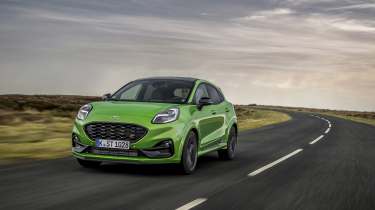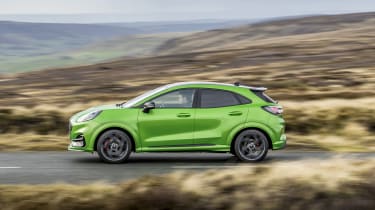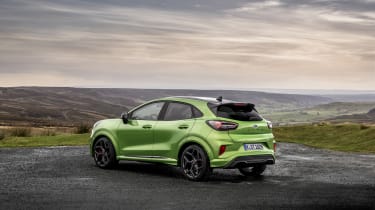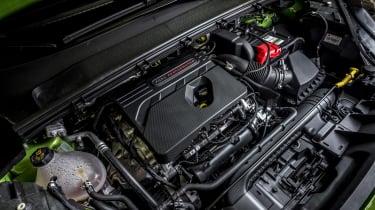Ford Puma ST (2020 - 2024) review – an icon rebooted
A slightly more grown up and practical take on the excellent Fiesta ST that we can’t help but wish was less crossover and more coupe
The Ford Fiesta ST is a hall-of-fame hot hatch in both its Mk7 and Mk8 forms, but its supermini proportions mean it won’t suit everyone for daily driver duties. If the larger, more practical but less tactile Focus ST Estate isn’t for you either, there’s another option from Ford to consider: the Puma ST.
You notice the Fiesta ST DNA after just a few minutes in the Puma. Actually, it’s evident as soon as you twist the key, because it uses the Mk8 Fiesta’s 1.5-litre turbocharged three-cylinder engine, which rumbles through the car and provides a 197bhp kick. In normal driving it’s the 236lb ft slug of torque that dominates, giving the Puma ST real flexibility.
> Ford Puma ST Powershift review – still a true ST?
At 1283kg the Puma ST is 78kg heavier than a five-door Fiesta ST, but you’ll recognise its ultra-keen feel from other fast Fords. The steering is quick, and despite being bigger than an ordinary supermini the Puma doesn’t occupy much space, making it easy to clip along on a tight back road. The extra height and weight over a Fiesta does ultimately make it less satisfying when pushing hard, however, and the wheel can tug at your hands when the full wallop of torque comes in from 2500rpm.
More reviews
By and large, though, you can drive the Puma like a hot hatch, and there are rewards to be had when you do. Lean on the nose into a corner and it’ll lift an inside-rear wheel in traditional hot hatch style, and there’s scope to nudge the back axle wide if you hold the brakes into a turn or sharply release the throttle. It lacks the Fiesta ST’s ultimate finesse and adjustability, but then most cars do. On the right roads the Puma ST can be a hoot to drive.
The optional Performance Pack is a must for unlocking the ST’s full potential, bringing launch control and, importantly, a Quaife limited-slip differential. A pair of thickly bolstered Recaro bucket front seats were standard (later versions get Ford Performance items) along with a flat-bottomed steering wheel, lifting what is otherwise a no-nonsense interior largely carried over from the Fiesta. The infotainment system feels well out of date in 2024, it must be said, but you do get a full digital dash and there’s a thumping B&O sound system with a subwoofer integrated into the rear bulkhead. Boot space isn’t much more useable than a Fiesta’s but there is a drainable storage box under the floor.
What to pay
In 2023, Ford introduced a mild-hybrid 1-litre version of the Puma ST called the Powershift, and though its dynamic character is largely the same, its more modest 168bhp engine and lack of a manual gearbox rob joy from the driving experience. The Performance Pack-equipped 1.5-litre ST is the better choice, and early examples cost around £16,000 today. Stretch your budget to a sub-60,000-mile 2022 model (starting from £18k) and you’ll have a chunk of manufacturer warranty left to fix any nagging problems, the most common of which is battery drain causing the car to enter a ‘deep sleep’ mode. A software update, reconditioning the battery or fitting a replacement can cure this.
Engine, transmission and 0-60 time
The Puma’s 1.5-litre Ecoboost turbocharged triple is just as strong as it was in the Fiesta. Its stats are similar, producing an identical 197bhp at 6000rpm, but a stronger 236lb ft of torque from 2500rpm. It also features cylinder deactivation under light loads plus a valved exhaust that’s switchable via the driver modes.
There’s only one transmission available, a six-speed manual, sending power to the front wheels via either an open, or Quaife limited-slip differential available as part of the £995 Performance Pack. Given the high-torque load available at such low rpm, we’d suggest it is an essential box to tick. It’ll reach 62mph in 6.7sec, 0.2sec behind a Fiesta ST.
Technical highlights
The Puma’s chassis is largely based on the Fiesta’s, sharing a similar combination of a Macpherson front suspension design and a twist beam rear axle. There’s no independent rear suspension, nor adaptive dampers, but the overall tune of the dampers is promised to be more forgiving than the Fiesta ST’s setup.
The Puma is a slightly bigger car overall compared to its supermini twin, with crucial differences being the 70mm wider body, an extra 95mm in the wheelbase and increased track widths of 27mm. It’s also 95kg heavier than the three-door Fiesta, yet the seating position is remarkably similar – a reminder this is more a low-riding crossover and not an SUV. There’s only the one wheel and tyre package available, with 19-inch alloys wrapped in a less aggressive Michelin Pilot Sport 4 rubber in contrast to the Fiesta’s Supersports.
Price and rivals
The hot Puma was bigger and better equipped than a Fiesta ST, yes, but it’s also far more expensive. Standard models started at £30,415, but the Performance Pack is an essential addition which takes the price north of £31k, over £6000 more than a Fiesta ST with a Performance Pack.
Without Nissan rebooting the Nismo Juke, there are no real direct compact crossovers as this is one of the few niches the mainstream Volkswagen Group hasn’t ventured into, and neither has FCA. Mercedes-AMG did offer versions of the similarly sized GLA, but they’re tens of thousands more, and likewise the Audi SQ2 and BMW X2 M35i, but the less said of that pairing the better.
It’s the more traditional hot hatchback that reveals a bigger gap in the Puma ST’s rationale, with the quite superb but now discontinued Hyundai i30 N and Renault Megane RS, not to mention the Toyota GR Yaris and Honda Civic Type R all proving that for around £30k there’s a whole lot more fun available at this price point. And it’s not like you’re losing any practicality with those hot hatchbacks, rather a crossover status, which in the Puma’s case is little more than a label.
Ford Puma ST specs
| Engine | In-line 3-cyl, 1497cc, turbocharged |
| Power | 197bhp @ 6000rpm |
| Torque | 236lb ft @ 2500-3500rpm |
| Weight | 1283kg |
| Power-to-weight | 156bhp/ton |
| 0-62mph | 6.7sec |
| Top speed | 137mph |
| Price new | £28,495 (2020-2024) |
| Value today | From £16,000 |







